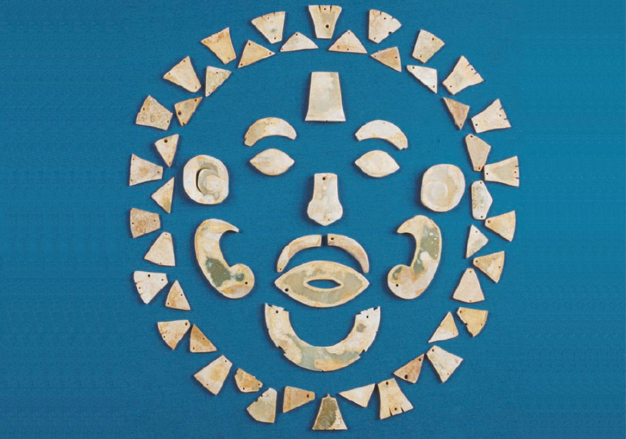Tomb M2001 of Guo Ji in Guo State Graveyard
Guo State is a vassal state ruled by monarchs surnamed Ji in the Western Zhou Dynasty. It belonged to Guo Zhong, the younger brother of King Wen of Zhou. In 658 BC, the troops of the Jin State passed through the Yu State and destroyed the Guo State. On their return, they captured the monarch of the Yu State and destroyed the Yu State as Well. This is the origin of the story of “destroying Guo State by the way of Yu State” and the proverb of “The lips being lost, the teeth feel cold”. Guo State quit the stage of history after being annexed by the Jin State.
Tomb M2001 of the Guo State Graveyard is a big tomb with unsuccessful excavation attempts by grave diggers. Altogether some 5,293 pieces of cultural relics were unearthed form the tomb, including more than 1,700 pieces of bronze ware and 121 pieces (sets) of jade ware. What’s the most important, the inscriptions with the name “Guo Ji” on the bronze ware provided the proof for identifying the owner of the tomb. “The First Chinese Sword” unearthed from the Guo Ji Tomb – an iron sword with jade handle and copper core – is the earliest material object made by smelting iron through manpower ever discovered in China.
Burial articles at the bottom of Tomb M2001 of Guo State Graveyard (South-North)
1. When jade masks were unearthed, the back sides of most of the jade pieces were facing the front. It was therefore ascertained that the front side of the jade mask was the side touching the skin of the dead. Is this a mistake made in haste or a special custom?
2. Why the jade pieces for the mask were made of used jade wares?
Your answer please, if you have any questions or answer, please fell free to send us email, we are waiting for your answer and participation, and your comments or answers will be highly appreciated. We will select and publicize the most appropriate answers and comments in the proper time.
Weekly Selection Email: meizhouyipin@chnmus.net
“Mingmu” is a piece of textile red in the back and black in the front with silk threads inserted in between. It is used to cover the face of the dead. Because the eyes are the most important organ on the face, it is therefore named “Mingmu”, literally “closing one’s eyes in death”.
Jade “Mingmu” or jade mask was first started by sewing small jade ware to the “Mingmu” in around Emperor Gong’s reign of the Zhou Dynasty. Till the mid and late Western Zhou Dynasty, the use of jade “Mingmu” had gradually matured and strict system had been formed for its usage. Unearthed jade masks of the Western Zhou Dynasty shows the fact that luxurious burial objects like these are only discovered in tombs of high-ranking nobles. Mid or low-ranking nobles and ordinary citizens are not allowed to use them. The masks are mainly unearthed in the sites of Jin State and Guo State of the Western Zhou Dynasty and the capital of the Eastern Zhou Dynasty. Tomb owners were mostly high-ranking nobles of the imperial family of the Zhou Dynasty.
Starting from the Eastern Zhou Dynasty, jade masks tended to be used by ordinary people. Especially since the late Spring and Autumn Period, civilians in the Sanjin Liangzhou Area (most part of Henan, Hebei and Shanxi Provinces) had popularly used masks made of stone pieces. The jade mask, therefore, had totally lost its original ritual significance. The development and decline of jade masks during the Western and Eastern Zhou Dynasties actually reflect the track of the “Rite of Zhou”, from its formation till its collapse. Since the late Spring and Autumn Period, jade burial objects with jade masks in the main had not only increased in quantity but also turned to be more colorful in design. Most of these objects are unearthed near Luoyang in the site of the Zhou capital. They are used in tombs of different ranks and only different in structure and design according to different identities, social statuses and family conditions of the tomb owners. Some are complicated and some are simple. Masks in high-level tombs are mostly made of jade pieces, while those in low-level tombs are made of stone pieces. Jade masks then changed into stone ones in the late Spring and Autumn Period and the Warring States Period.
In the late Warring States Period, the use of jade masks declined. There are indications that in some high-level tombs, jade garment was used. There’s a kind of inheritance between the jade mask and the jade garment. The face cover of the jade garment, in particular, is similar to jade mask in its function, material and method of making.
Jade mask first appeared in the mid Western Zhou Dynasty, and was the most popular during the late Western Zhou Dynasty, the Spring and Autumn Period and the Warring State Period. In the Western Han Dynasty, it started to decline due to the appearance of jade garment. So far, more than 40 sets of jade masks have been unearthed in Shanxi, Shaanxi, Henan, Jiangsu, Hubei, Shandong and other provinces, dating back to the period between the Western Zhou Dynasty and the Western Han Dynasty.
In 1984, a jade mask was discovered in Tomb M157 of Jingshu in the Western Zhou graveyard in Zhangjiapo of Chang’an County, Shaanxi Province. It consists of several jade articles.
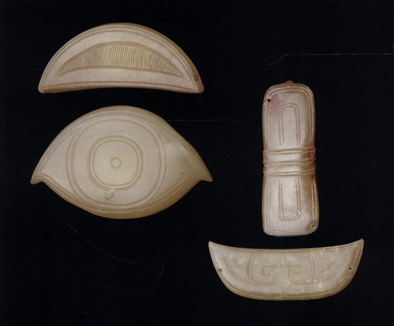
Components of jade mask discovered in Tomb 157 of Zhangjiapo
graveyard of Chang’an County, Shaanxi Province
The jade mask unearthed in Tomb M303 in Zhangjiapo consists of 15 jade pieces and reflects the human facial feature. From the graveyard of marquises of Jin State in the site of Qucun Village of Tianma in Shanxi Province, several sets of jade masks were unearthed. This shows that the use of jade masks was a major feature of the burial system of the Zhou Dynasty.
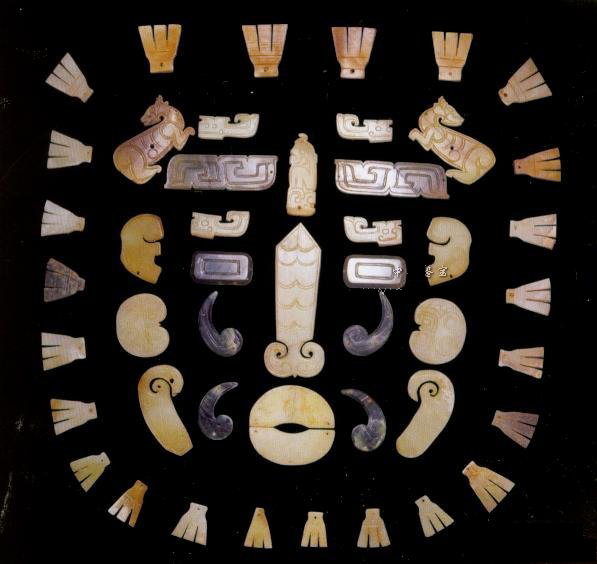
Jade mask unearthed from Tomb 62 at the graveyard of marquises of Jin State in Quwo County of Shanxi Province
Besides, the jade mask unearthed from Tomb D9M1 of Zhenshan Mountain in Hushuguan of Jiangsu’s Suzhou City, is composed of jade pieces imitating the eyebrows, nose, eyes and mouth of human face. It basically remained in its original place when being discovered. The owner of the tomb was a king of the Wu State in the mid or late Spring and Autumn Period.
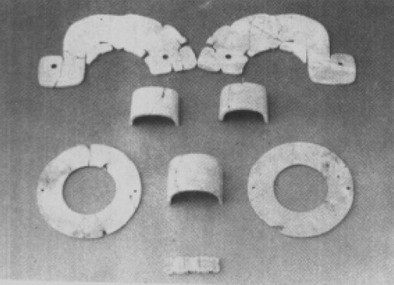
Jade mask unearthed from the grand tomb of Zhenshan Mountain
at Hushuguan of Suzhou city, Jiangsu Province
The jade mask unearthed from Tomb M2 of Qinjia Mountain of Hubei’s Jingzhou City in 1997 is a complete piece of jade carved with the human facial features. The mask, complete with all the five sensory organs and even hair and eyebrows, was made after the real person. The tomb owner was a female belonging to the rank of Yuanshi in the late mid Warring States Period.
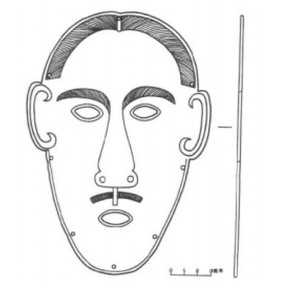
Jade mask unearthed form Tomb M2 at Qinjia
Mountain of Jingzhou, Hubei Province
In the Han Dynasty, the jade garments were commonly used after the death of imperial nobles, the jade masks therefore declined gradually. So far, only three sets of jade masks have been found from tombs of the Western Han Dynasty. The most delicate mask was unearthed from the tomb of Liu Kuan, the last king of Jibei State of the Western Han Dynasty, in Shuangru Mountain of Changqing County, Shandong Province.
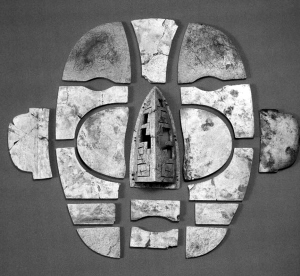
Jade mask unearthed from the tomb of Liu Kuan,
the last king of Jibei State of the Western Han Dynasty
The Han Dynasty is a critical period in China’s jade culture development history. In this period, people not only inherited what had been achieved in the past, but also realized new accomplishments. It is also a prime time for the development of burial jade articles.
Analysis of the unearthed jade masks indicate that Zhouyuan, Chang’an, Luoyang, and the Sanjin Area (most part of Henan, Hebei and Shanxi Provinces) are places where jade masks were the most popular in both the Western and Eastern Zhou Dynasties. The structure and design of the jade masks are almost the same, indicating that jade masks had already fixed their form by then. Jade mask represents a special form of burial jade articles. The jade mask unearthed in Sanmenxia for instance, not only can help us study the history of Guo State, but also reflects the development stage and continuity of burial jade articles.
The large-scale Guo State graveyard has tombs of different ranks of the late Western Zhou Dynasty. It was orderly arranged, well preserved and enjoys unique feature. Altogether three sets of jade masks have been unearthed here, among which the one discovered in 1991 in Tomb M2001 of “Guo Ji” is the most complete, most standard in structure and the most delicate in craftsmanship. The owner of Tomb M2001 is Guo Ji, king of Guo State.
The jade mask was found covering the face of the tomb owner. Though the jade pieces were in disorder when being found, the facial contour of the mask could still be recognized. It consists of 14 thick jade pieces imitating the male facial organs, 44 pieces of thin jade pieces in triangular, trapezoid, trifurcate and irregular shapes, and 68 red agate beads stitched on the cloth. They all help to form the facial contour. The jade pieces representing facial organs are placed in the center, surrounded by two circles of jade pieces. The two circles, each consisting of 22 pieces of jade, help to form the facial feature. The inner circle is mainly composed of triangular jade pieces while the outer circle mainly consists of trapezoid and trifurcate pieces. Under almost all the jade pieces, there are one to three red agate beads, obviously used to tie knots and fix the jade pieces on the mask. Each of the jade pieces, generally 3 millimeters thick, has two to three holes. Apart from the few penetrating from the back to the front, most of the holes are in the back, penetrating through the two sides of the piece. From the red silk thread remaining in some holes, we can ascertain that red silk thread was used for sewing the jade mask. In the back of some jade pieces, traces of textiles were found, and they should be the remains of the supporting cloth of the mask.
All the jade pieces are made from Hetian green jade from Xinjiang. Apart from the jade Huang piece representing the lower jaw, all the other pieces are made of used jade ware. The side with patterns is normally put in the back and the plain side to the front.

